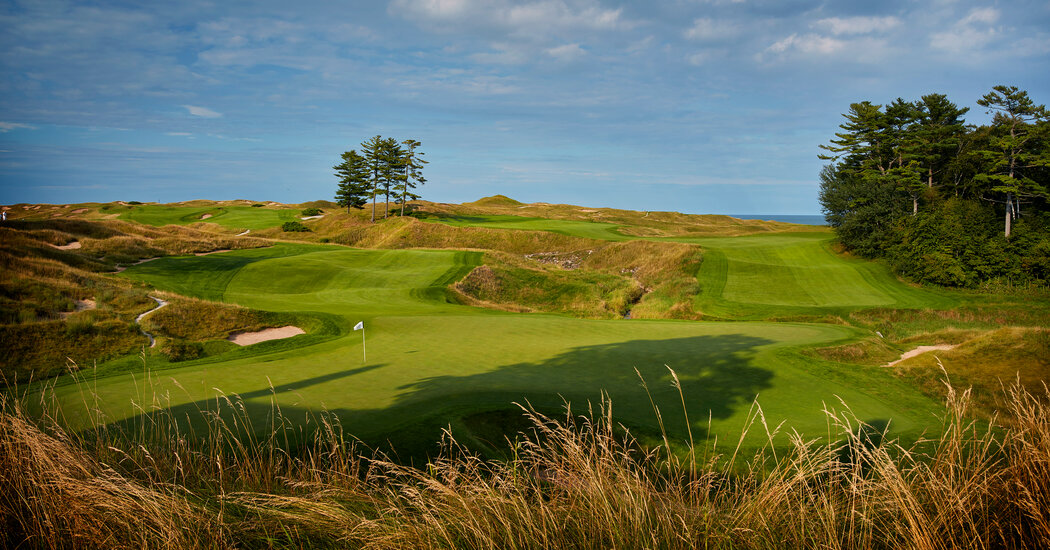As part of golf’s current crop of fast-rising talent, Justin Thomas of the United States understands the importance of expanding his international horizons. No doubt, though, there’s an underlying reason behind adding the Open de France to this year’s summer schedule.
It’s a scouting trip.
In three months, Le Golf National, site of this week’s Open, will enjoy an even bigger spotlight as host of just the second Ryder Cup to be played in continental Europe. Unlike European pros who can tee it up at Le Golf National’s Albatros course outside of Paris every year, Thomas is taking advantage of a rare chance to get an early look.
“I’m excited to see the course,” said Thomas in a statement, now back to No. 2 in the world rankings after recently spending four weeks atop the chart. “It’s not like a Ryder Cup or a Presidents Cup in the States where we can just pop over and play when we want. I’m hoping to get some good vibes from it.”
Just how many other Americans might endeavor a sneak peek remains to be seen. Jim Furyk, the captain of the United States team, is putting the finishing touches on an outing next month for his Ryder Cup hopefuls, though attendance is optional.
As it stands, perhaps only Thomas will have seen the Albatros under tournament conditions since the course got a Ryder Cup tweak two years ago. As the Americans seek to win on European soil for the first time in a quarter-century, course familiarity could be a factor.
“We love this golf course,” said the European captain Thomas Bjorn. “I believe we could win on any golf course in the world, but there is a home advantage in the sense that we know the golf course very well.”
Le Golf National has been part of the European Tour schedule since 1991, and since then has hosted every edition of the Open but two. As such, this week’s event doesn’t necessarily represent a test run for September.
[READ MORE: A Golfer’s Debate: To Play, or not to Play]
The event’s list of winners includes such standouts as Graeme McDowell, Colin Montgomerie, Martin Kaymer and the defending champion Tommy Fleetwood.
It’s a prime example of the contrast in how the two sides embrace their host venues. The Americans gravitate to sites with major championship pedigree — Hazeltine National, Medinah, Oakland Hills — that offer an iconic backdrop but require players on both sides to get familiar with the layout.
Europe, on the other hand, almost always taps into its top tour destinations.
Gleneagles in Scotland, site of the 2014 matches, was the host of the Johnnie Walker Championship for 15 years. The K Club (2006) in Ireland staged 12 editions of the European Open. Valderrama in Spain was the site of the Volvo Masters for a decade before the Ryder Cup arrived in 1997.
“One thing that Europe’s done very well is they play on courses where they hold European Tour events,” Furyk said. “Most of their players have access to courses that our players haven’t seen before. They have a home-field advantage, which is very wise, and here they picked a venue that their players like.”
Le Golf National, sculpted from farmland southwest of Paris near Versailles, was designed with the purpose of becoming a hub for French golf. The Albatros is the showpiece among three courses, flanked by the Aigle and the nine-hole Oiselet layout.
[READ MORE: A French Golfer Takes a Hard Look at Golf in France]
“It’s made for the Ryder Cup,” Kaymer said. “It’s great for spectators, especially the last five holes.”
Water plays a prominent role in the finishing stretch, and spectator mounds help create a feel not unlike T.P.C. Sawgrass and the Players Championship.
“You have to hit the ball straight,” Furyk said. “You have to be accurate. Coming down the stretch, you’ve got a lot of water, almost a stadium-like atmosphere around holes 15 through 18. I think it’s going to be a great venue.”
For all the approving reviews, though, the Open de France has drawn few American entrants in recent editions. Of the players projected to contend for a Ryder Cup roster spot this fall, only the two-time United States Open champion Brooks Koepka and Matt Kuchar have played Le Golf National in the past five years.
That isn’t to say Americans haven’t produced good finishes. Peter Uihlein, a member of both the PGA and European Tours, was runner-up last year behind Fleetwood. Kevin Stadler tied for second four years ago.
Furyk might want to consider a captain’s pick for Brendan Steele, winner of last fall’s Safeway Open who owns three top-10 finishes at Le Golf National since 2011.
But of the likely top 15 players in Europe’s pool, all but four have taken on Le Golf National sometime in the past two years.
“We’re playing on a golf course that they know and they love,” Furyk said.
It’s why Furyk hopes a number of players will take him up on an invitation to check out Le Golf National on the weekend before the British Open. After two days of getting a feel for the Albatros, the group would travel to Carnoustie for the year’s third major.
However, he’s quick to note several may be involved in the Scottish Open or John Deere Classic ahead of Carnoustie.
“We seem to have a bunch of players that hang out together, and I would love to see them make a trip,” Furyk said.
“Now I realize everyone’s different,” he added. “We all have obligations and we have events that we may want to play. I would love to see some of them come, but it’s not going to be a requirement. I think it’s going to be an ask and an invite, and I would hope to see some of those players.”
Once the final putt falls Sunday, work will begin to convert the Albatros layout from a mere tournament site into one that can handle Ryder Cup crowds expected to approach 65,000.
Among the changes will be a new first-tee grandstand, allowing some 6,500 spectators to take in — and contribute to — one of the most electric atmospheres in golf. The grandstand will be configured to also provide views of the 18th green.
By contrast, the grandstand in 2016 around Hazeltine National’s first tee held 1,668 fans; Gleneagles (2014) had a grandstand seating of 2,148.
In a statement, Edward Kitson, the Ryder Cup match director, summed up the expectations for the larger crowd and the tournament over all.
“There’s no doubt the atmosphere will be incredible.”
Source : NYtimes














